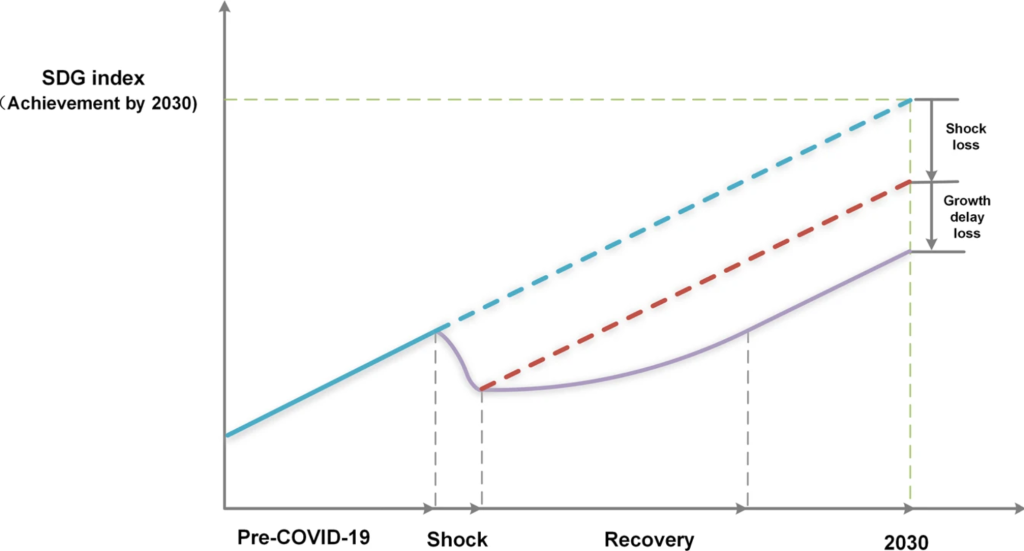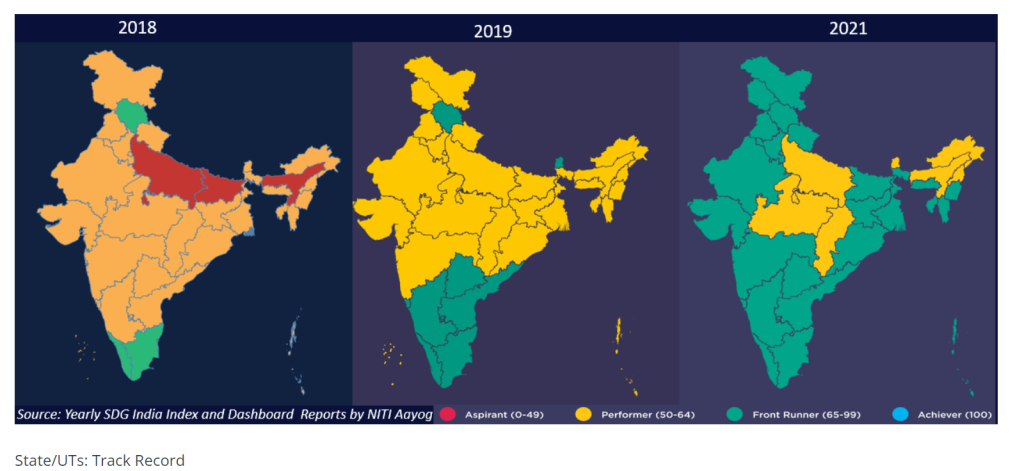CONTENTS
- This is the Year to Get the SDG Goals Back on Track
- The Trouble with the SC’s Electronic Voting Machines (EVM) Verdict
This is the Year to Get the SDG Goals Back on Track
Context:
The United Nations summit on Sustainable Development Goals (SDGs), convened in New York on September 18-19, evaluated the advancement toward realizing the SDGs. The Agenda-2030, adopted by the UN General Assembly in 2015, outlines 17 SDGs along with 169 specific targets to reach by 2030. While the program is not legally binding internationally, all nations have pledged to strive towards these objectives, recognizing the pursuit of sustainable development as a shared global undertaking.
Relevance:
GS3-
- Inclusive Growth
- Environmental Pollution and Degradation
- Conservation
- International Treaties and Agreements
Mains Question:
Using relevant reports and data, analyse how has the world progressed towards attainment of objectives under the Sustainable Development Goals (SDGs). With 2024 being the election year across the world, discuss what could be done to progress further in this direction? (15 Marks, 250 Words).
Analysing the Progress on SDGs:
- Reports indicate that progress has been somewhat on track between 2015 and 2019, albeit insufficient to meet the goals. The onset of the COVID-19 pandemic and other global crises have severely impeded progress.

- Concerningly, there has been little attention paid to goals concerning the environment and biodiversity, such as responsible consumption and production, climate action, life below water, and life on land.
- Furthermore, the current approach to pursuing SDGs fails to acknowledge their interconnected and indivisible nature. We are distant from the overarching aim of balancing human well-being with a healthy environment.
- If the current trajectory persists, it will result in accelerated environmental degradation, undermining the purpose of transitioning towards sustainability.
UN SDG Report of 2023:
- Given this evolving situation, the UN SDG Report of 2023 outlined five crucial areas requiring immediate attention:
- First, governments must commit to seven years of accelerated, consistent, and transformative actions to fulfill the promises of the SDGs.
- Second, there is a need for concrete, integrated, and targeted government policies and initiatives to eradicate poverty, reduce inequality, and address environmental degradation, with a particular focus on advancing the rights of women and girls and empowering the most vulnerable.
- Third, there is a necessity to enhance national and subnational capabilities, accountability, and public institutions to facilitate accelerated progress.
- Fourth, the international community must reaffirm its commitment to providing and mobilizing resources to support developing nations.
- Finally, there is a call for continued reinforcement of the UN development system.
Findings Worthy of Discussion:
- A group of 64 scholars undertook an analysis of 3,000 studies, primarily peer-reviewed articles from around the world, to explore the “Scientific evidence on the political impact of the sustainable development goals” within both national and global governance frameworks.
- Their aim was to address pressing challenges like poverty eradication, social justice, and environmental protection.
- Published in the September 2022 issue of the journal Nature Sustainability, these findings merit broad deliberation, particularly concerning the implementation of Agenda 2030.
- The authors examined five dimensions: global governance, domestic political systems, the integration and coherence of institutions and policies, the inclusiveness of governance from local to global levels, and the protection of ecological integrity.
- They concluded that, thus far, the SDGs have primarily had discursive effects but have also spurred some isolated normative and institutional reforms.
- However, these effects are often diffuse, and there is scant evidence that global goal-setting directly influences political dynamics at the national and local levels.

- Overall, their assessment suggests that while there are limited impacts of the SDGs, they do not singularly drive transformative change.
Way Forward:
- Acknowledging this situation, world leaders have reaffirmed their commitments and agreed to intensify efforts to achieve the SDGs, which serve as our global roadmap out of the crisis by 2030.
- However, the extent to which these global declarations translate into actionable initiatives at the grassroots level remains uncertain.
- In this context, the UN report “Future is Now” (2019) offers potential guidelines for action.
- It underscores that the full transformative power of the 2030 Agenda can be harnessed through a systemic approach that identifies and manages trade-offs while maximizing co-benefits. Co-benefit activities are those that, while addressing one SDG, also contribute to progress on others simultaneously.
- The report recommends adopting locally appropriate entry points based on regional and national priorities and leveraging four key levers—governance, economy and finance, individual and collective action, and science and technology—to drive actions along these entry points.
- Stakeholders across these levers should forge partnerships and establish innovative collaborations to design and swiftly implement integrated pathways to sustainable development tailored to each country’s specific needs and priorities. This collective effort is essential for contributing to global transformation.
Conclusion:
The year 2024 marks an election year worldwide. In at least 64 countries, encompassing both developed and developing nations and representing 49% of the global population, elections will take place. It is perhaps crucial for all newly elected governments to contemplate the sustainability issue and align their national policies accordingly.
The Trouble with the SC’s Electronic Voting Machines (EVM) Verdict
Context:
The 2022 Nobel Prize in Physics was granted to three physicists for validating the existence of quantum entanglement, a natural phenomenon. The recent Supreme Court ruling on the petition challenging the Election Commission’s procedures regarding EVM security could draw insights from this Nobel-winning effort as it emphasized the significance of trusting technical data and steering clear of blind distrust in the electoral system.
Relevance:
GS-2
- Democracy
- Constitutional Bodies
- Government Policies and Interventions
Mains Question:
What have been the recent developments in India in the context of EVM security and how has the judiciary responded to it? Should software intended for public use in a democracy be open source? Examine. (15 Marks, 250 Words).
Background:
- During the hearing on April 24, Justices Sanjiv Khanna and Dipankar Datta engaged in enlightening discussions with the lawyers, particularly in two notable instances.
- In the first instance, advocate Santhosh Paul representing the petitioners argued that electronic voting machines (EVMs) possess a “source code” that should be made public for independent verification.
- In response, Justice Khanna expressed the view that the source code should remain undisclosed to prevent misuse if disclosed.
- In the second instance, when questioned about the possibility of reprogramming the microcontrollers within the EVM’s components, an Election Commission (EC) official asserted that such reprogramming was not feasible.
- However, advocate Prashant Bhushan, representing the petitioners, challenged this assertion by referring to data from the microcontrollers’ manufacturer, suggesting that reprogramming was indeed possible.
- Justice Khanna then acknowledged the official’s clarification and emphasized the need to rely on the EC’s technical expertise.
- In a final instance, the bench delivered its verdict on April 26, rejecting the suggestion to revert to paper ballots and cautioned against a “blind distrust” of the system, stating that it hampers progress.
Analysing the Discussion:
Through these instances, two key points emerge: firstly, the security of EVMs seems to hinge on an unspecified “source code,” and secondly, there’s a concern that understanding how the system operates could jeopardize its normal functioning. Both of these notions are seen as detrimental to democracy.
Asserting the Safety of Electronic Voting Machines:
- While the petitioners’ request to revert to paper ballots was clearly impractical, it’s unreasonable to dismiss doubts every time they arise, especially if addressing those doubts wouldn’t incur significant expenses, as was the case here.
- By simply asserting the safety of electronic voting machines (EVMs), without providing an opportunity for them to be visibly proven safe, the EC missed an important chance.
- This sets a questionable precedent, particularly because the core issue at stake is trust in the electoral process.In his concurring opinion, Justice Datta advocated for a “critical as well as constructive approach guided by evidence and reason,” contrasting it with “blind distrust.”
- However, both the EC and the court seem to have favored blind trust over skepticism. While distrust impedes progress, unquestioning acceptance undermines accountability.
Mere Understanding of the Software’s Working:
- Furthermore, understanding how certain software functions doesn’t inherently compromise its security.
- For instance, despite the widespread use of the WordPress content management system and the accessibility of its source code, it remains popular and secure.
- Despite thousands of individuals being knowledgeable about how WordPress operates, this doesn’t equate to the ability to hack WordPress websites.
- It’s not unreasonable to expect the software operating within electronic voting machines (EVMs) to adhere to the same standard.
- If it did, it would be independently verifiable and could benefit from the expertise of ethical testers to enhance its reliability, rather than relying on a secret known only to the Election Commission (EC), with potential unknown modes of failure.
Source Code Disclosure:
- There are established cryptographic techniques that allow for external verification without increasing the vulnerability of an EVM.
- These techniques include tests that challenge the system’s schematics without requiring them to be disclosed, similar to how a website’s server can confirm the correctness of a password without knowing its actual value.
- It’s worth noting that the software underlying electronic voting systems in countries like Germany, the U.S., and Venezuela is open source, demonstrating the feasibility and benefits of such an approach.
- However, as of 2023, the Election Commission (EC) had not subjected the source code to an audit by a public authority.
- Both in 1990 and 2006, the Technical Expert Committee recommended that the EC disclose the source code. In 2013, it proposed a security test for the software without revealing its specifics.
- Nevertheless, the electoral body consistently declined to share the source code when civil society members sought it through legal channels.
- The issue here is that courts have approached these matters from a constitutional standpoint, whereas the systems executing the code operate on mathematical principles, which are less protected by constitutional safeguards alone.
- The fact that a software program is proprietary doesn’t inherently make it more secure; in fact, it may be less so due to fewer individuals being able to scrutinize it.
- Essentially, software intended for public use in a democracy should be open source to ensure perpetual reliability and eliminate the need to place trust solely in a single vendor.
Conclusion:
Such software must be trustworthy, maintaining a reputation that isn’t constantly subject to questioning, and lack of trust, meaning it doesn’t necessitate relying solely on someone else’s assurance regarding its integrity.





